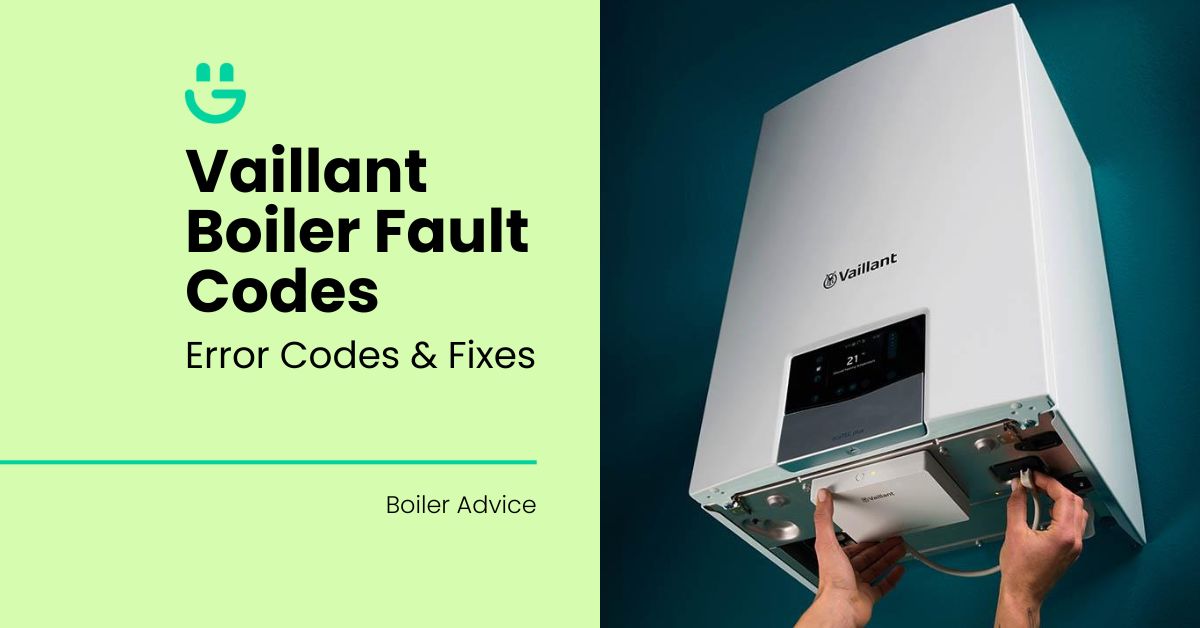Last Updated on November 14, 2025
As a Vaillant boiler owner, understanding fault codes is useful in ensuring your boiler operates efficiently and safely. Familiarising yourself with these codes can help you detect issues early on and prevent costly damages.
Moreover, recognising when a professional engineer is needed can save time and money and ensure your and your home’s safety.
In this post, we’ll provide a guide on Vaillant boiler fault codes, ranging from common to advanced, and explore how to prevent and address these issues.
We’ll cover ignition-related fault codes, water pressure and circulation fault codes, temperature sensor fault codes, and delve into the more advanced gas valve, fan, and electronic fault codes, including the Vaillant fault code.
By the end, you’ll have a thorough understanding of Vaillant boiler error codes and know when to call a Gas Safe engineer for assistance.
Contents
Vaillant Boiler Error Code – Overview
- Vaillant Boiler Fault Codes provide an overview of common Vaillant boiler error codes, their meanings and potential solutions.
- Routine maintenance and servicing can help prevent fault codes related to ignition, water pressure/circulation, temperature sensors and flame simulation.
- For any Vaillant errors, it is recommended to consult a Gas Safe Registered engineer for diagnosis and resolution.
Vaillant Error Codes
You might have seen a fault code on your Vaillant boiler, and you don’t know what it means. Well, we are here to help, giving you more of an idea of what each error code means and what you can do about them.
Vaillant boiler error codes are designed to help users identify potential issues with their heating systems. These codes typically appear on the boiler’s display panel and can range from simple temperature sensor errors to more complex issues within the Vaillant Ecotec Plus system.
For example, a heating part load error may be caused by a malfunctioning gas valve, while a boiler error code related to water pressure and circulation might indicate a problem with the pump or water pressure sensor.
Being aware of these fault codes can aid in taking the correct action when a problem occurs. This blog post covers common and advanced Vaillant boiler fault codes, explains their meanings, and suggests potential solutions.
This knowledge will help you to take the necessary steps to keep your boiler running smoothly and efficiently.
Common Vaillant Boiler Fault Codes
Now that we have established what a Vaillant boiler error code is, we can go into which ones are most commonly displayed and what each means.
Common Vaillant boiler fault codes involve issues with:
- Ignition
- Water pressure
- Temperature sensors
- Flame simulation faults
These codes can be attributed to various factors such as short circuits, interruptions, flame signal error air, or even flame simulation faults.
The following subsections provide detailed explanations of frequent fault codes linked to ignition, water pressure, and temperature sensor problems.
Ignition-Related Fault Codes
Ignition-related fault codes indicate issues with the startup process of your Vaillant boiler. One common example is the F28 error code, which signifies a boiler ignition fault due to a significant temperature difference.
This code may appear if the ignition process was unsuccessful upon startup, possibly due to an insufficient gas supply or a mechanical fault with the gas valve.
Another ignition-related fault code is the F87 error code, which indicates a problem with the electrodes, potentially related to gas valve regulation.
To fix these problems, consider calling a gas-safe engineer to examine connections, remove any blockages in the condensate pipe or pump, and assess any faults in the electrical wiring. The engineer may also need to confirm a gas supply to the property and check the gas flow pressure.
Routine maintenance and servicing can aid in avoiding ignition-related fault codes. This includes:
- Assessing the pressure, temperature, and safety devices
- Cleaning filters
- Inspecting the primary heat exchanger
- Checking for any blockages or debris
Water Pressure and Circulation Fault Codes
Water pressure and circulation fault codes are related to issues with the boiler’s water pressure and circulation system. These codes can impact the hot water operation burner and may indicate a safety switch-off due to low boiler water pressure, as seen in the F22 error code.
Other examples include the F25 error code, which suggests a high flue gas temperature, and the F23 error code, indicating excessive temperature variation and inadequate water circulation.
Resolving these problems requires a thorough inspection of the boiler’s water pressure and circulation system, including pressure change detection. This may involve checking the water pressure sensor, addressing any leaks, and ensuring there is sufficient water in the boiler.
In some cases, it may be safe for a you to replenish the boiler’s water pressure or check the DHW outlet sensor for issues.
However, if the problem persists or is more complex, it is necessary to enlist the services of a gas-safe engineer to diagnose and resolve the issue accurately.
Preventing water pressure and circulation fault codes can be achieved through routine maintenance tasks like cleaning filters and inspecting the heat exchanger.
It is also important to monitor the boiler’s water pressure and address any fluctuations promptly.
Temperature Sensor Fault Codes
Temperature sensor fault codes are related to issues with the boiler’s temperature sensors, such as the flow and return temperature sensor. These codes typically appear when the temperature alteration registered at these sensors is minimal or nonexistent, indicating a possible temperature sensor error.
Common examples include the F25 error code, which implies a high flue gas temperature, and the F24 error code, indicating a rapid temperature increase.
Fixing temperature sensor fault codes may involve the following steps:
- Inspection of the flow temperature sensor and return NTC sensors or wiring.
- Checking the positioning of the sensors at the pipe.
- Ensuring there is sufficient water in the boiler.
In some cases, such as the F83 error code, it is recommended to contact a professional to accurately diagnose the cause of the error, as it may be due to a variety of potential issues, including a leak in the system or a sensor error.
Regular maintenance and servicing can help prevent temperature sensor fault codes. This includes:
- Assessing the pressure, temperature, and safety devices, including the safety switch off temperature and temperature limiter
- Cleaning filters
- Inspecting the primary heat exchanger
- Checking for any blockages or debris
Advanced Vaillant Boiler Fault Codes
Beyond common Vaillant boiler fault codes, there are more intricate fault codes related to gas valves, fans, and electronic problems. Understanding these advanced fault codes can help you identify and address more complicated issues with your Vaillant boiler.
The subsequent subsections offer detailed insights into these advanced fault codes and suggest possible remedies.
Gas Valve and Supply Fault Codes
Gas valve and supply fault codes are related to issues with the boiler’s gas valve and supply system. For example:
- The F61 error code denotes a malfunctioning gas valve
- The F88 error code indicates a fault with the gas valve itself
- The F62 error code indicates that the gas valve is malfunctioning
Resolving gas valve and supply fault codes necessitates the following steps:
- Inspection and replacement of faulty components like the gas valve, wiring harness, or PCB.
- Elimination of any clogs to ensure adequate gas flow and pressure.
- Confirmation of communication between the gas valve and boiler components.
- Assessment of the electronics and resolution of the issue by a gas-safe engineer if necessary.
Regular maintenance and servicing can help prevent gas valve and supply fault codes. This includes:
- Assessing the pressure, temperature, and safety devices
- Cleaning filters
- Inspecting the primary heat exchanger
- Checking for any blockages or debris
Fan and Flue Fault Codes
Fan and flue fault codes are related to issues with the boiler’s fan and flue system. These codes can indicate problems such as a faulty fan, as seen in the F32 error code.
Other examples include the F28 error code, which signifies an ignition or gas valve issue that may be caused by a mechanical fault in the gas valve, a frozen condensate pipe, or an electrical wiring fault.
Fixing fan and flue fault codes requires an examination of the fan and flue system. This may involve verifying that the fan is properly connected and operational, as well as checking for any leaks or frozen condensate pipes.
If your issues continue and you aren’t sure about what you can do to fix them, you should contact a gas-safe engineer so they can correctly identify and solve the problem.
Regular maintenance and servicing can help prevent fan and flue fault codes. This includes:
- Assessing the pressure, temperature, and safety devices
- Cleaning filters
- Inspecting the primary heat exchanger
- Checking for any blockages or debris
Electronic and PCB Fault Codes
Electronic and PCB fault codes are related to issues with the boiler’s electronic components and printed circuit boards (PCBs).
These codes can include the F90 error code, which indicates a communication error between the boiler’s PCB and user interface, and the F67 error code, which signifies a flame signal fault on the main PCB.
Rectifying electronic and PCB fault codes involves:
- Inspecting the boiler’s electronic components
- Replacing any defective parts if needed
- Checking the flame signal and the boiler’s PCB and user interface
- In some cases, a gas-safe engineer may need to assess the electronics and resolve the issue.
Regular maintenance and servicing can help prevent electronic and PCB fault codes. This includes:
- Assessing the pressure, temperature, and safety devices
- Cleaning filters
- Inspecting the primary heat exchanger
- Checking for any blockages or debris
How To Prevent Vaillant Fault Codes
It’s one thing to know what the fault codes are and how to fix any boiler problems you have, but it’s another to learn how to prevent them in the future.
Avoiding Vaillant boiler fault codes plays a significant role in maintaining the longevity and efficiency of your heating system.
By performing regular maintenance and servicing, you can detect and resolve potential issues before they escalate. Here are some tips to help prevent common Vaillant boiler fault codes:
- Use a smart control or thermostat: Modern thermostats can help you monitor your boiler’s performance and identify potential issues early on. By keeping an eye on your boiler’s temperature and pressure, you can address any fluctuations promptly and avoid fault codes.
- Insulate your home: Properly insulating your home can help retain heat and reduce the strain on your boiler. This can help prevent issues related to temperature fluctuations and water pressure.
- Bleed radiators periodically: Air trapped in your radiators can cause uneven heating and put unnecessary strain on your boiler. Bleeding your radiators regularly can help maintain optimal performance and prevent fault codes.
- Schedule annual servicing: Regular servicing by a Gas Safe registered engineer can help identify and resolve potential issues before they escalate. This includes assessing the pressure, temperature, and safety devices, as well as cleaning filters, inspecting the primary heat exchanger, and checking for any blockages or debris.
When To Call An Engineer for Vaillant Error Codes
Although some boiler error codes can be handled by a handy individual, knowing when to call a gas-safe engineer for help is vital. A professional engineer has the expertise and qualifications to handle complex boiler issues safely, ensuring the safety and efficiency of your heating system.
It is recommended to consult a Gas Safe Registered engineer for any errors, excluding minor repairs such as defrosting the condensate pipes, bleeding the radiators, or replenishing the boiler pressure.
For more complex problems, like a boiler not igniting, a lack of hot water, or any other problems that could pose a risk to your safety or property, contacting an engineer immediately is necessary. Additionally, issues with a condensate pump may require professional assistance.
Remember that regular maintenance and servicing can help prevent many common Vaillant boiler fault codes and keep your heating system running smoothly.
By contacting a professional engineer when necessary, you can make sure your boiler is safe and efficient and enjoy peace of mind.
Vaillant Fault Codes – Final Thoughts
After going through all of the details about Vaillant fault codes, we hope you have a better understanding of Vaillant boiler fault codes and why they are essential for maintaining a safe and efficient heating system.
By familiarising yourself with common and advanced fault codes, you can take the necessary steps to address issues promptly and prevent potential damages.
Regular maintenance and servicing, as well as knowing when to call a gas-safe engineer, is an excellent way of ensuring the longevity of your Vaillant boiler.
As a responsible homeowner, it is vital to keep your boiler in optimal working condition.
By following the tips and advice outlined in this blog post, you can prevent common Vaillant boiler fault codes and enjoy a warm, safe, and comfortable home for years to come.
FAQs
What are the fault codes on a Vaillant boiler?
Vaillant boilers typically feature error codes when a fault occurs with the boiler, providing useful diagnostic information.
How do I clear my Vaillant fault code?
To clear a Vaillant fault code, press the reset button for up to 10 seconds before the boiler resets. Check to see if the flame has ignited or if the error code has disappeared.
Why is my Vaillant boiler showing a communication fault?
It appears that your Vaillant boiler is showing a communication fault due to a failed main PCB or display PCB, which will need to be replaced.
How do I reset my Vaillant error?
To reset a Vaillant ecoTEC boiler, press and hold the reset button (usually displayed as a flame with a line crossed through it) for one to three seconds. If this doesn’t reignite the boiler, you can contact a qualified gas-safe engineer who will be able to help.
How can I prevent Vaillant boiler fault codes?
Regular maintenance, using a smart control or thermostat, insulating your home, bleeding radiators, and scheduling annual servicing with a Gas Safe registered engineer are all effective ways to prevent Vaillant boiler fault codes.






Tom Allen
Solar Expert